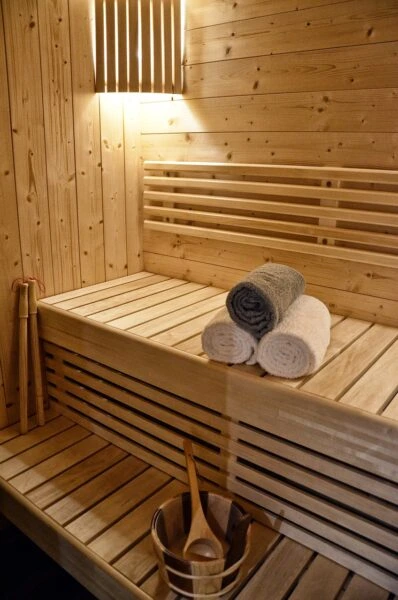How Long Can You Safely Stay in a Sauna? | Benefits and Guidelines
Understanding proper sauna usage time is essential to reaping the many benefits a sauna has to offer. As a rule of thumb, 15 to 20 minutes is a good sauna session length for most people.
Whether you’re wanting to relax or relieve muscle tension, staying hydrated is essential, since saunas promote high fluid loss via sweat. So the rule of thumb here is to listen to your body. If at any point you start to feel dizzy or uncomfortable, exit the sauna immediately.
If you’re just getting started with steam room use, it’s important to start with shorter sessions. Increase your time gradually, once you feel comfortable.
In this post, we’ll explore the ideal sweat session duration, its benefits, and tips to enhance your sauna experience for maximum enjoyment.
Why Sauna Time Matters
Knowing how long to use the steam room is key for getting the most health benefits possible. Each minute you spend in the sauna sets off a cascade of physiological responses. This alone does wonders for your cardiac health and provides a huge lift to your psychological health.
Finding the right balance between enjoying these benefits and being informed about risks is important. For maximum benefits, spend 15 to 20 minutes in the sauna. Keeping in this 20–30 minute window allows your body to reap the rewards without pushing it too far.
Understand the Core Benefits
The most impressive evidence in favor of sauna use is its positive effects on cardiovascular health. Improved blood flow can help you develop a stronger heart. Heat shock proteins help increase your muscle recovery.
This is why sauna sessions are most effective immediately following a workout. Regular sauna visits yield amazing mental health benefits. This can make a big difference in reducing stress, anxiety, and insomnia, resulting in a much deeper, more restorative state of relaxation.
In addition, sweating helps with the detoxification process, which helps eliminate toxins from your body. Regular sauna bathing can support immune function, enabling you to better ward off infections and illnesses.
Avoid Overdoing It
Even with all these positives, it’s important to understand the signs of too much sauna use to avoid serious health threats. As always, listen to your body – if you start to feel lightheaded or overly tired, make sure to exit.
Follow the suggested sauna time of up to 20 minutes max per session. This helps you maximize the benefits while avoiding the risks associated with excessive heat exposure. Safety and wellness are always of the utmost importance, so moderation is key.
How Long Can You Stay in a Sauna?
Knowing how long to stay in a steam room is key to getting the most health benefits while staying safe. How long you can stay in a sauna depends on your overall health, experience level, and the type of sauna.
1. General Time Guidelines: How Long Should You Stay?
Saunas are generally safe for most people for 15 to 30 minutes. Beginning with shorter sessions will help your body get accustomed to the heat. Since sweating is an important part of the detox process, anywhere from 15 to 20 minutes is usually plenty.
Here’s a quick guideline:
- First-time users: 5-10 minutes
- Casual users: 15-20 minutes
- Experienced users: Up to 30 minutes
2. First-Time Sauna Users
If you are new to the steam room, start with 5 – 10 minute sessions. This method, in turn, will give you the best sense of how your body is responding to the heat.
Slowly, as you get used to things, you can start to push your time. Pay attention to your body so you don’t push beyond your limits, and take notes on your sauna experiences to gauge your progress over time.
3. Experienced Sauna Goers
If you’re more experienced, you may feel comfortable with longer sessions—up to 30 minutes. With heat acclimation, you can stay in a sauna for longer, but pay attention to your body’s signals.
Exploring different sauna styles and temperatures can help you get the most out of your sessions. Hydration becomes even more important with any prolonged use.
4. How Long for Heat Shock Proteins?
For inducing heat shock protein production, target at least 20 minutes per session. Heat shock proteins are key factors in muscle recovery and cellular protection.
Finding the proper balance in your steam room time versus other recovery methods will bring you the best results. Think of actions such as stretching or hydration prior to and following sauna exposure to maximize these effects.
Factors Influencing Your Sauna Time
Understanding the factors that affect how long you can comfortably stay in a sauna is essential for maximizing your experience. Your tolerance will be entirely personal. Five key factors determine this variation, starting with the type of sauna you choose, your overall health, and age.
Sauna Type Matters
Each sauna type has its distinct environment. Typically, traditional saunas are heated to a blistering 195°F. So, to play it safe, I recommend keeping your sweat sessions relatively short. 15 to 20 minutes is ideal.
Infrared saunas are somewhat different, operating at lower temperatures, usually between 120 to 150°F. This allows you to safely have longer sweat sessions of up to 30 minutes. Each type of sauna has its benefits. Where traditional saunas provide a more intense heat near the skin’s surface, infrared alternatives are known for their more indirect warmth that penetrates deeper into the skin.
As with most things, sauna, your comfort, and preferences will drive your decision here.
| Feature | Traditional Sauna | Infrared Sauna |
| Temperature | 160-200°F | 120-150°F |
| Humidity | 10-20% | Low to Moderate |
| Session Length | 15-20 minutes | Up to 30 minutes |
Temperature and Humidity
Temperature and humidity have a huge impact on sauna time. For safety reasons, the hotter the sauna, the shorter the sitting time should be. For instance, steam rooms, which function at nearly 100% humidity, are more effective in shorter durations (10-20 minutes) and require less time in each session.
Keeping an eye on these factors will allow you to maximize the experience and benefits you reap.
How Your Health Status Affects How Long You Can Safely Stay
Certainly, pre-existing health conditions will be a big factor in how long you should steam room. If you have underlying conditions such as heart disease or respiratory illness, you must speak with your healthcare provider.
Your overall fitness levels will influence how well you can tolerate the heat, so shorten your sauna sessions if you’re still not feeling great.
Age as a Factor
Age has a profound effect on heat tolerance. Especially for older adults, shorter sessions are usually necessary to maintain health and safety. Gradual acclimatization to heat is especially key for them, as age-related physiological changes can alter recovery.
Listen to Your Comfort Level
Above all, listen to your body and sauna at a level that’s right for you. If you start to experience lightheadedness or fatigue, it’s a good idea to leave, since prolonged exposure to high heat can cause dehydration.
Being mindful of your body’s cues will ensure you’re getting the most out of your time in the sauna.
Health Benefits of Sauna Use
The health benefits of regular steam room use are numerous and can have an impact on your physical health, mental health, and overall quality of life. Recognizing all these benefits gives you a clearer picture of why taking regular sauna sessions is worth it.
How Long to Stay for Cardiovascular Benefits
Regular steam room use can greatly improve cardiovascular health. Long exposure to heat helps boost blood flow and circulation, which gives your heart higher efficiency levels.
Studies indicate that frequent sauna use dramatically reduces the risk of CVD. They do this in part by improving blood pressure control. Over time, with each sauna visit, you’re making positive strides in your heart health, which means a stronger, more resilient body.
Muscle Recovery and Pain Relief
Sauna heat therapy helps with post-exercise muscle recovery. That’s because the heat from the sauna increases blood flow, resulting in reduced muscle soreness and stiffness, so you can recover faster from workouts.
Improved circulation during sauna sessions speeds up healing, providing relief from sore muscles and discomfort. Finding the right balance of sauna use with other recovery techniques will help you get the most out of all of these benefits.
Stress Reduction and Relaxation
Sauna sessions induce a state of relaxation and have been shown to cut stress levels by nearly 70%. The impact of the heat creates a calming response on your nervous system, helping you to relax deeply.
With these profound benefits, regular steam room use not only leads to better mental health but to better sleep as well. As one relaxes, there is a release of tension throughout the body, resulting in a greater feeling of well-being.
Skin Health Benefits
Increased circulation leads to healthier skin as blood flow improves, nourishes and replenishes the outer skin layers. Sweating while you spend time in the soothing heat of hot tubs helps to detoxify your skin and purify clogged pores.
This complex cascade of events results in improved skin elasticity and appearance and the prevention or improvement of multiple skin conditions. Being well hydrated on the inside is just as important as keeping your skin well hydrated when using a sauna!
Risks of Overstaying: How Long Is Too Long?
If you spend too much time in a steam room, you’ll increase the risk of many hazards. Understanding these risks is key to having a fun and safe way to ride. Let me unpack the chief concerns — first up is dehydration.
Dehydration Risks: Signs You’ve Stayed Too Long
Excessive sweating in a sauna can result in dehydration. With each run, like your body with each sweat, your body is getting depleted. Without greatly replenishing those lost fluids, you will run into some severe dangers.
It’s important to stay hydrated before, during, and after your sweat session. Signs of dehydration may include dry mouth, dizziness, confusion, and extreme thirst or fatigue. To replace fluids lost through sweating, drink water often and think about electrolyte beverages.
Here are some hydration tips for sauna users:
- Drink water before entering the sauna.
- Keep a water bottle nearby during your session.
- Rehydrate with fluids after your sauna time.
- Avoid alcohol and caffeinated drinks, as they can dehydrate.
Overheating and Heatstroke
Getting too hot is another danger. Signs of exposure include nausea, confusion, and a rapid heartbeat. If you begin to feel ill, leave the steam room right away.
Environmental factors such as high humidity and longer durations further put you at risk of heat-related illnesses. Pay attention to your body and stay vigilant with an oral thermometer.
Cardiovascular Strain
Whether in a hot tub or sauna, prolonged use can overwhelm your heart. It’s extremely important to remember to monitor your heart rate.
People who already have cardiovascular disease should be extra careful. Moderation, as always, is the magic ingredient to good heart health. If you’re pregnant or have other health issues, you’ll want to speak to your healthcare professional about the sauna.
Dizziness and Fainting
Dizziness and fainting are concerning signs. If you start to feel faint, you should exit the steam room immediately.
Contributing factors are dehydration and overheating. Allow for a proper cool down from your session to avoid injuries. Do so with a hawk eye, monitoring your body’s responses.
Who Should Avoid Sauna Use?
Sauna use has many positive effects on the body. However, some populations need to exercise caution or avoid them altogether. Being aware of these potential risks may protect you from serious harm. People with underlying health concerns should be sure to consult a healthcare provider first before indulging in a sauna soak. Tailored suggestions make sure that you’re doing it the correct way according to your health condition.
Heart Condition Considerations
Those who experience heart conditions should be especially cautious with sauna usage. Prolonged exposure to high temperatures can wreak havoc on the cardiovascular system by raising heart rate and blood pressure. This is why consulting a doctor before you step into a steam room is important, as they can give you individualized advice.
Paying close attention to how your body reacts during sweat sessions is extremely important. If sauna use is risky, finding other therapies like mindfulness relaxation techniques could prove effective and safer.
Pregnancy Precautions
Pregnant people should use saunas with care. High exposure to heat is known to affect fetal development. It is essential to consult a healthcare provider to make sure steam room use is safe, especially for pregnant women.
Second, be aware of sauna temperature and length of time. Alternative relaxation methods, such as gentle yoga or meditation, can provide safer alternatives during pregnancy.
Low Blood Pressure Concerns
People who have low blood pressure have particular risks in saunas, such as fainting or dizziness. Special care should be taken when coming into very hot environments. The important thing is to monitor your body’s reaction.
If you have blood pressure issues, speak to your doctor about whether sauna use is right for you. Being mindful of your blood pressure is important, and adjusting your sauna time accordingly can help improve safety.
Other Medical Conditions
One of the biggest factors as to whether or not chair sauna use is safe is personal health status. Here’s a brief list of conditions to consider:
- Epilepsy
- Kidney disease
- Respiratory issues
Safe Sauna Practices
Regular sauna sessions are a healthy, soothing indulgence, as long as you’re practicing safe sauna. Learning the safest ways to have a fulfilling sauna experience means you can maximize enjoyment, all while focusing on your well-being.
Hydrate Before, During, and After
Drinking water before entering the sauna is very important. This preparation should go a long way towards ensuring that you stay hydrated as you’re sweating it out.
Once you’re in the sauna, replacing what you’ve lost is key to staying properly hydrated. Hydration during steam room use isn’t just to avoid discomfort; it’s key to your body’s health. With dehydration causing dizziness and fatigue, it’s worth taking a proactive approach.
Here are some hydration strategies:
- Consume a minimum of 16 ounces of water before your session.
- Keep a water bottle handy inside the sauna.
- Consume water or electrolyte-rich drinks after your session.
Start Slowly and Gradually Increase Time
Starting out with brief sauna sessions is a good idea, so you can gauge how you feel. Once your body gets used to it, you can start increasing the length of your sessions.
Pay attention to how you feel to determine your ideal sauna duration. Each individual’s tolerance will differ, so allow yourself plenty of time to get acclimated.
Cool Down Properly Afterwards
Cooling down after sauna use is every bit as significant as the heat exposure itself. It’s important to transition safely from the heat to cooler environments, as this helps in recovery.
Avoidance of excessive exposure to heat, including self-cooling measures like bathing in cool water or spending time in an air-conditioned environment, improves comfort. Pay attention to your body temperature as you go through this process.
Avoid Alcohol and Heavy Meals
Avoiding alcohol in the hours before and after sauna use is essential. Alcohol can make you more prone to dehydration and general discomfort from your sweat session.
A very heavy meal may cause nausea, so keep snacks light if necessary before your session.
Monitor Your Body’s Signals
Most importantly, listen to your body while you’re in the sauna. If you start to feel lightheaded or dizzy, or just unwell, that’s your cue to get out.
By paying attention to your body, you can have a safer experience and enjoy all the benefits of the sauna. Listening to your body and tailoring your sauna sessions will help you get the most out of your sauna experience.
Recognize Warning Signs
Knowing how to read steam room warning signs is important to keep you as safe and healthy as possible. Recognize warning signs and listen to your body. This knowledge will allow you to reap all the benefits of sauna use while avoiding any health dangers. Keep an eye out for these warning signs that tell you it’s time to exit the sauna to protect your health.
Dizziness or Lightheadedness
Dizziness or light-headedness is an unmistakable warning sign—it’s time to leave the sauna. More typically, these feelings are related to dehydration or overheating. If you do start to feel faint, realize that you need to cool down right away.
Be vigilant to recognize the warning signs to prevent a mishap from occurring. Here are steps to take if you experience dizziness:
- Sit down and take deep breaths.
- Drink water to rehydrate.
- Move to a cooler area.
Excessive Sweating or Paleness
Excessive sweating can be a sign of overheating, and paleness can be a sign of distress. If you start to experience these symptoms, it’s important to take steps to cool down immediately.
Being mindful of how your body is reacting can keep your sauna session safe and enjoyable. Hydration is an important part of keeping these problems at bay. We recommend deeply hydrating before and after use.
Nausea or Headache
Just as important as any health caution, nausea or headaches are red flags at any time while using the sauna. These same symptoms can result from heat exposure or dehydration. If you start feeling ill, leave the sauna immediately.
Keeping an eye on your body’s response is the best way to avoid creating more discomfort. Here’s what to do if you experience these symptoms:
- Move to a cooler environment.
- Sip water slowly.
- Rest until you feel better.
Rapid Heartbeat
A consistently elevated heart rate when exercising is a sure sign that you are overheating and/or overstraining your body. Monitor your heart rate throughout sauna sessions. Once it starts to get fast, it’s time to go.
By learning how to identify physiological indicators of heat exposure, you can ensure your sauna experience is not just enjoyable but also safe. Recognize warning signs and take them seriously.
Different Types of Saunas
Saunas are available in a wide array of types, each providing their own unique atmosphere and benefits. Knowing these distinctions will go a long way towards helping you pick out the perfect sauna for your lifestyle and preferences.
Here’s an in-depth look at the different types of saunas and what makes each one special.
Traditional Saunas (Finnish)
Traditional Finnish saunas are perhaps best known for their searing heat. Temperatures are usually between 150°F and 195°F, and humidity is quite low. This powerful natural synergy creates the perfect environment for a deeply relaxing and detoxifying experience.
Sauna culture in Finland, sauna bathing is a lively cultural practice. Since it’s a representation of health and well-being, it becomes so much more than just an activity.
The full experience usually features the waving of birch branches to improve circulation. That magical vibe, along with the comforting warmth, makes it one of the best places to unwind after a long day and melt your stress away.
Infrared Saunas
Infrared saunas only use lower temperatures, typically ranging from 120°F to 150°F, while providing all the same great health benefits. By utilizing infrared technology, these saunas penetrate deeply into the skin, helping with detoxification and relaxing sore muscles.
The heat is more tolerable, allowing you to be more comfortable, which allows you to stay longer. So you’re able to easily increase your time spent in them, even 45 minutes.
This specific sauna, in particular, has skyrocketed in wellness circles. It’s even been shown to relieve pain, improve circulation, and more.
Steam Rooms (Turkish Baths)
Steam rooms, often found in Turkish baths, have high humidity and typically between 110°F to 120°F. Since the moist heat is great for respiratory health, saunas can be great for anyone with allergies or asthma.
Far more than just relaxing at the spa, the cultural importance of Turkish baths goes past self-care — they’re communal spaces that continue wellness traditions.
Like a sauna, steam rooms help to hydrate the skin and provide a one-of-a-kind therapeutic escape. Instead, you’ll walk out feeling clean, revitalized!
| Type | Temperature Range | Humidity Level | Key Benefits |
| Traditional Sauna | 150°F – 195°F | Low | Detoxification, relaxation |
| Infrared Sauna | 120°F – 150°F | Low | Muscle relaxation, pain relief |
| Steam Room | 110°F – 120°F | High | Respiratory health, skin hydration |
How Long Is Too Long in a Sauna?
Learning how long to spend in a sauna not only protects your health but also increases the health benefits and comfort of sauna bathing. Extended exposure can cause detrimental physiological changes and health risks. Understanding these factors ensures safe sauna use.
Physiological Changes During Exposure
So, as you use a sauna, your core body temperature increases, often to about 100 to 104 degrees Fahrenheit. At the same time, your heart rate goes up, frequently reaching 120 beats per minute or higher. Your body compensates for this by sweating, which evaporates off your skin and cools your surface, allowing you to keep a constant internal temperature.
Over time, especially with regular sauna use, the body makes positive adaptations, including better circulation and a more efficient sweat response. It’s important to pay attention to what your body is telling you. If you begin to feel lightheaded or overly tired, it’s time to go.
Documented Health Risks
Staying in a steam room for too long can be hazardous to one’s health. The longer you stay in, the more likely you are to become dehydrated, which can result in dizziness, headaches, and fatigue. Excessive heat can put a lot of strain on your cardiovascular system, even more so if you have underlying health conditions.
Past documented cases of heat-related illnesses serve as a reminder of this important fact. It’s important to follow these guidelines and keep to 15 to 20-minute sessions max. Be mindful of your body’s signals, and be sure to leave the sauna at any point you begin to feel unwell.
Individual Tolerance Levels
As always, everybody tolerates heat differently. Your age, fitness level, and overall hydration status all play a role in determining how long you should be able to stay in a sauna comfortably.
As you use the sauna, some will discover they can adequately handle longer sessions, while others will require a shorter exit time. Self-awareness is key—by paying attention to your body, you’ll be able to figure out what sauna time is right for you. If you start to feel adverse effects, it’s best to reduce duration.
Recent Research on Sauna Use
Recent research sheds light on the beneficial effects of sauna use on health and wellness. Researchers are still investigating how the frequency of sauna use, as well as the length of each session, can influence these positive effects. Undoubtedly, as you explore this subject, you’ll find that frequent sauna use dramatically improves heart and vascular health.
It improves mood and patterns of thinking and prevents premature death.
Frequency, Session Length, and Health
Knowing the proper frequency of sauna use is important. Guidelines to date have called for this frequency at 2 to 3 times a week to achieve the most benefit. Even short sessions of 15 to 20 minutes can be beneficial.
When you increase your time to 30 minutes, you can increase those therapeutic effects. For others, beginning with shorter durations to build up tolerance seems a convenient approach. It’s important to get in tune with your own body’s cues – make note of what makes you feel good and modify as needed.
Personalization is key. Individual needs are different, and we must always be mindful that one person’s gold standard treatment may be another’s poison. Some people might do better with more frequent sessions, others might do best with less frequent sessions but longer duration.
Record your experiences and how you feel each time you go to the sauna. Keeping track of your sauna use with this personal log can guide you in creating a routine that perfectly matches your lifestyle and health aspirations.
Long-Term Health Benefits
Committing to consistent sauna use has proven to have significant long-term health benefits. Recent research suggests that regular sauna bathing lowers the risk of dying from heart disease and stroke by as much as 50–60%.
Regular sauna use has been associated with reduced stress and improved mood, leading to better overall mental health. Ongoing research continues to examine sauna therapy’s effects on various health conditions, expanding our understanding of its role in wellness practices.
With continued research, it has become increasingly evident that incorporating regular sauna sessions into your day can significantly improve your overall health and wellness. Take this easy, enjoyable, and effective step toward improved well-being!
Conclusion
Enjoying the powerful benefits of spending time in a sauna is very possible, but understanding how long you should spend there is important. Target about 15-20 minute sessions at first. Approximately this much time that’ll maximize your enjoyment and keep you safe. Pay attention to how you feel and don’t go beyond your abilities. If you start feeling nauseous or overheated, leave right away.
Be mindful of your health and any preexisting conditions that could impact how you use the sauna. There’s a unique vibe to each sauna type, so dip in and see what’s calling for you the most.
Relax into the heat and serenity that a sauna offers. It’s a relaxing practice that can easily be incorporated into your routine to improve your health. So get started and discover how taking a sauna can improve your life!







